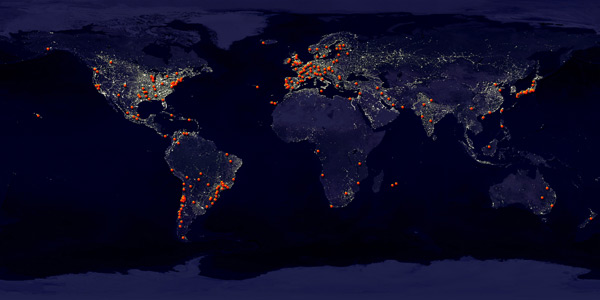About From Earth to the Universe
![]()

Introduction
Astronomical images objects of beauty, art, culture, and, of course, science. We propose to help generate and facilitate exhibitions of astronomical images around the world in a variety of settings during IYA 2009. These multi-wavelength images would come from both professional and amateur astronomers using a variety of space and ground-based observatories.
One crucial goal of this effort would be to place these images in "non-traditional" locations. That is, we hope that in addition to having these images featured in "traditional" settings such as science centers and planetariums, other types of locations such as public parks, metro stations, art centers, and others would be host to these images. In short, we hope to expose astronomy to the general public in an unexpected yet accessible manner.
Selection of images
A call has been placed to those actively known to engage in producing astronomical images for the public and the images are currently being ranked into groupings. Details of the image submission can be found in website given at the end of this text. Because some limits needed to be set, the decision was made to include only data images of astronomical objects. No artist's illustrations, spacecraft or hardware graphics, or other related visuals will be used. Ultimately, we hope to select 100 that will serve as the core of the exhibit. Local organizers may choose to add to this core with images or other materials or displays that to the location that is hosting. Such flexibility and creativity is encouraged.
Venues
As mentioned above, one main goal of this project will be to expose astronomy to audiences that might not otherwise come into contact with it. Or, in other words, we hope to "surprise" the public with these images in settings in which they are not accustomed to finding science. If we can make these images (and the science behind them) available in such a way, we hope that we can engage individuals who might normally fear or dislike astronomy in particular or science in general.
A map showing locations where interest has been expressed in hosting an IYA image exhibition in 2009:

[high-res image - JPG 1.8 MB]
Scalability
As we plan for IYA 2009, there remain many unknown factors. Issues such as funding, location availability, and other major planning elements are still waiting to be determined. Therefore, we suggest that this concept has the greatest likelihood for success if we can create a flexible plan that can accommodate a wide range of support in a host of different settings. Below we outline the basic categories we have designed. These "levels", however, should not be seen as absolutes. Rather, a particular exhibit may incorporate various elements based on the sensibility of that location and the local interest and support.
"Platinum" exhibit
As the name suggests, this is the most ambitious and, of course, expensive of our ideas. We envision a semi-permanent outdoor exhibit (see mock-up above) in a prominent location such as the National Mall in Washington, DC, or the Champs Elysee in Paris. Such "under the sky" installations would require illumination at night and high-quality weather proofing treatments. The core exhibit of images could be enhanced with such features as interactive kiosks, large-scale sky maps, alternatives for visually-impaired and other challenged visitors.
"Gold" exhibit
As with the platinum level, the gold exhibit would consist of up to 100 astronomical images in large printed format, roughly 4 x 3 feet in size, with appropriate captions. In order to keep costs to a minimum, these images could be directly mounted on pre-existing walls (see mock-up above) or less expensive stands with less sophisticated or no additional lighting. Simple packaging could be developed so that it would be relatively inexpensive to ship these images to multiple locations. Or, depending on printing costs in a particular location, the exhibit could alternatively be duplicated.
"Silver" exhibit
This is the "do-it-yourself" version of the image exhibit for science centers, planetariums, and other interested groups. The images would be available for "off the shelf" or pre-existing technologies such as light boxes, large-scale prints, or other formats already being used at any given location (see mock-up above).
Read more about the FETTU Cornerstone Project on the PDF article: The Universe from Earth: A Cornerstone for the IYA2009 presented at the conference Communicating Astronomy with the Public 2007

